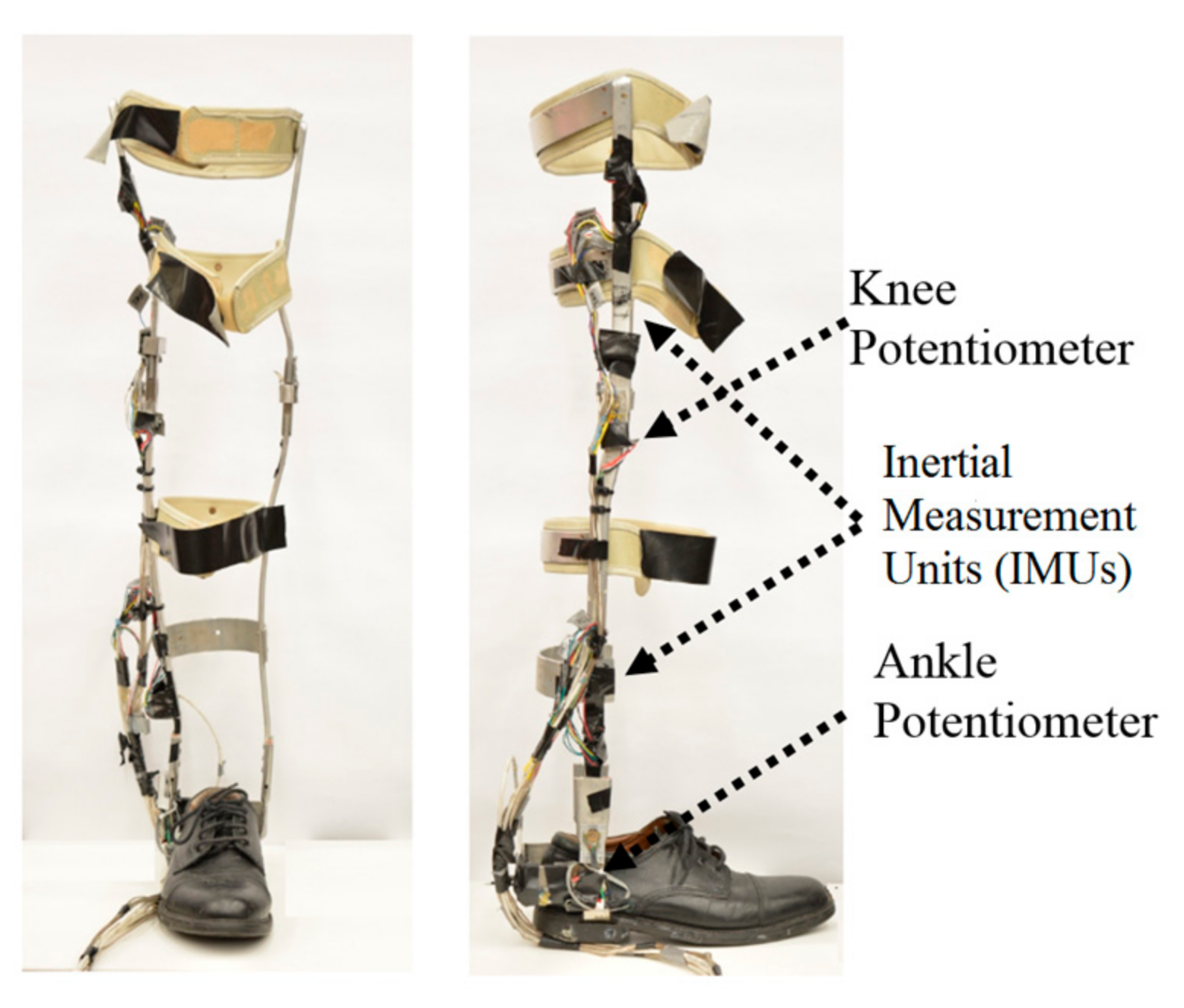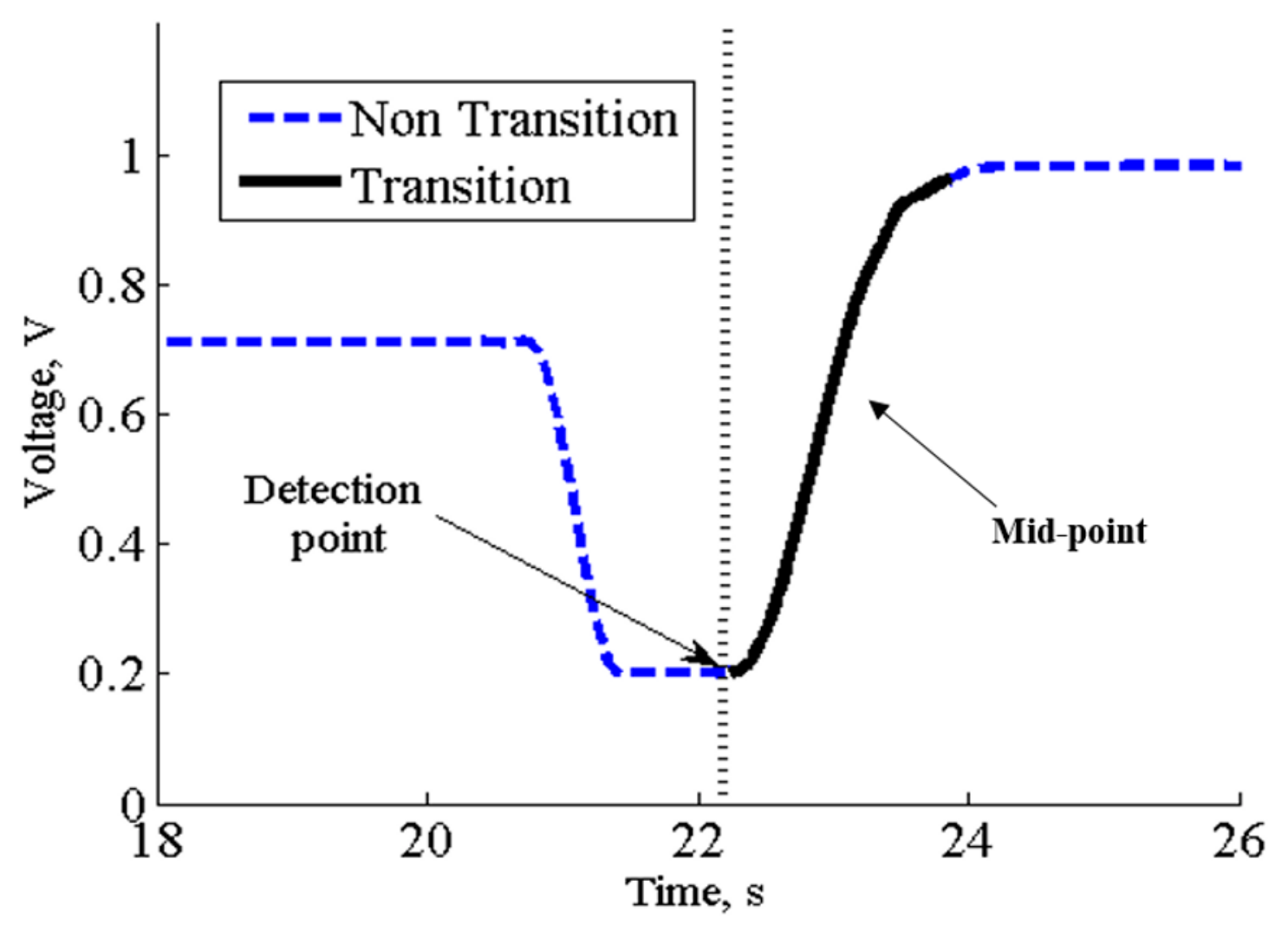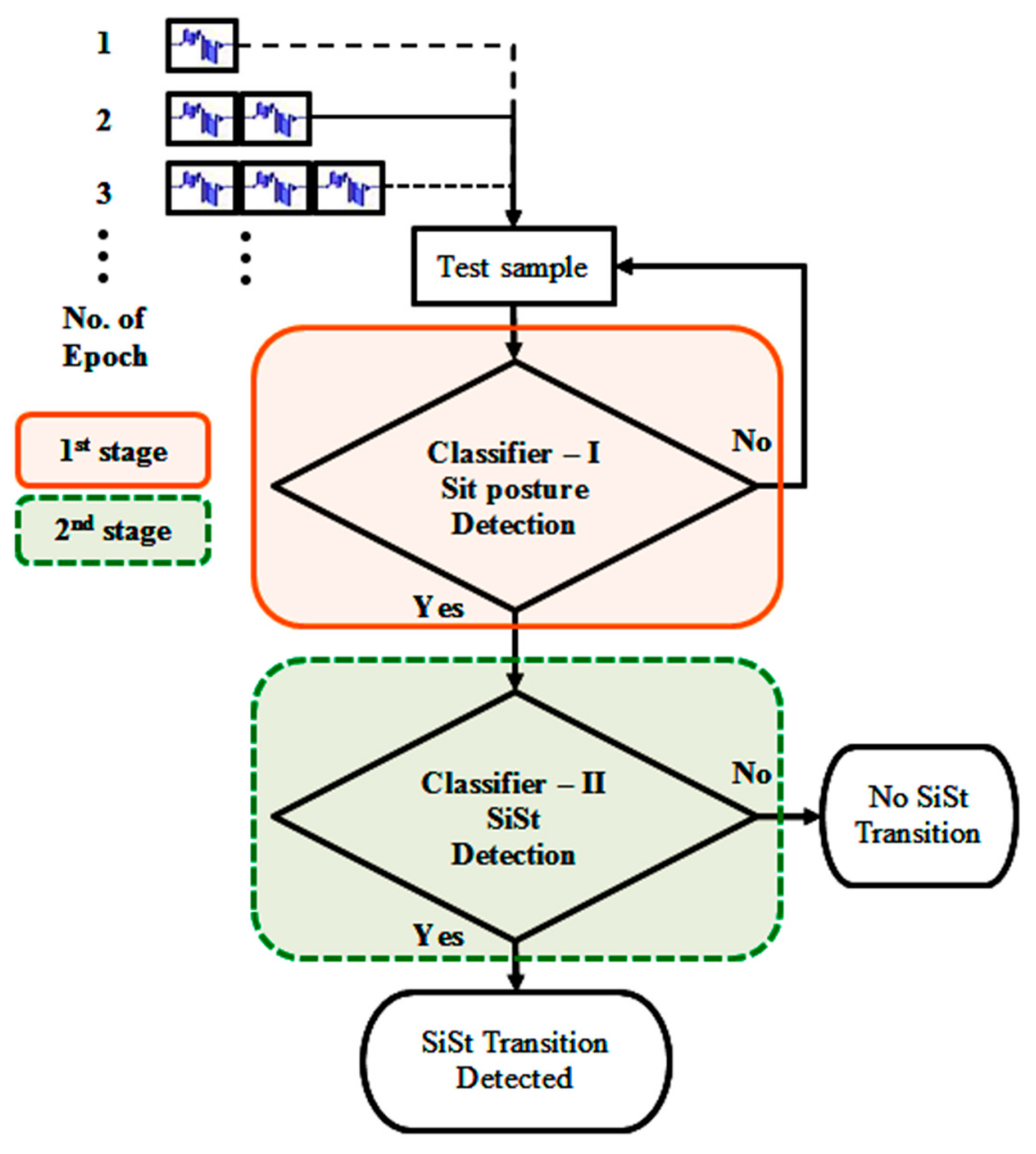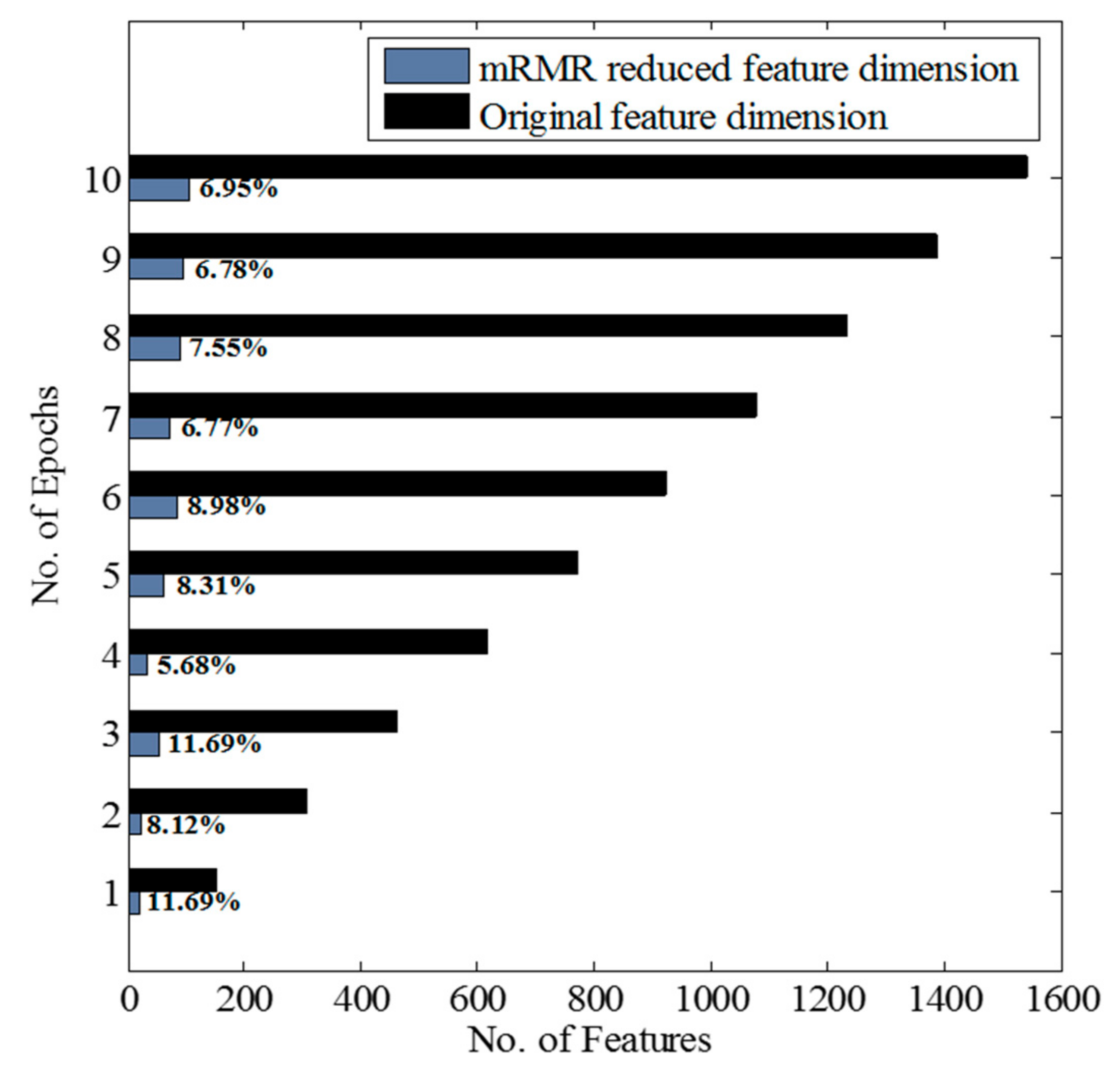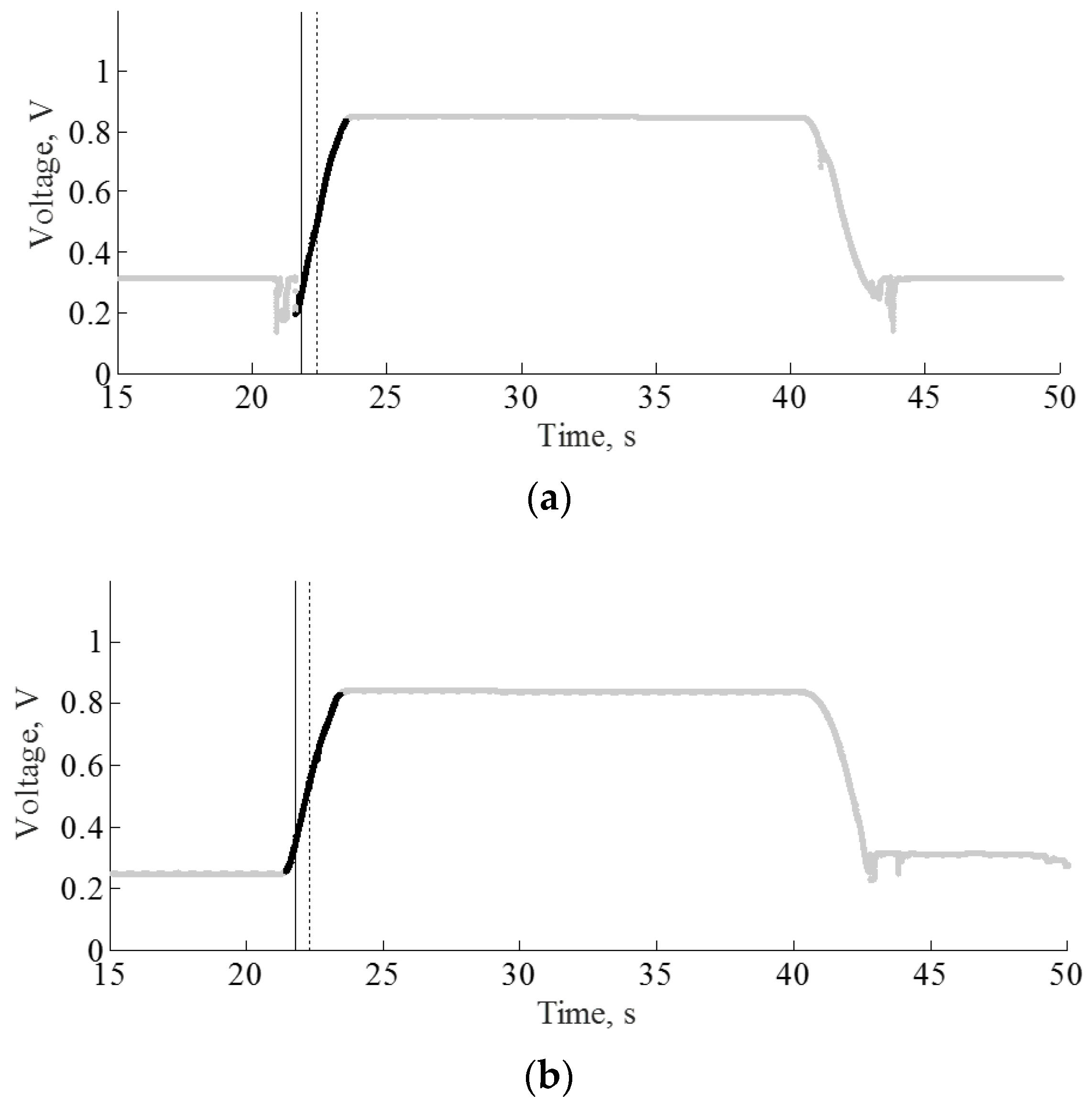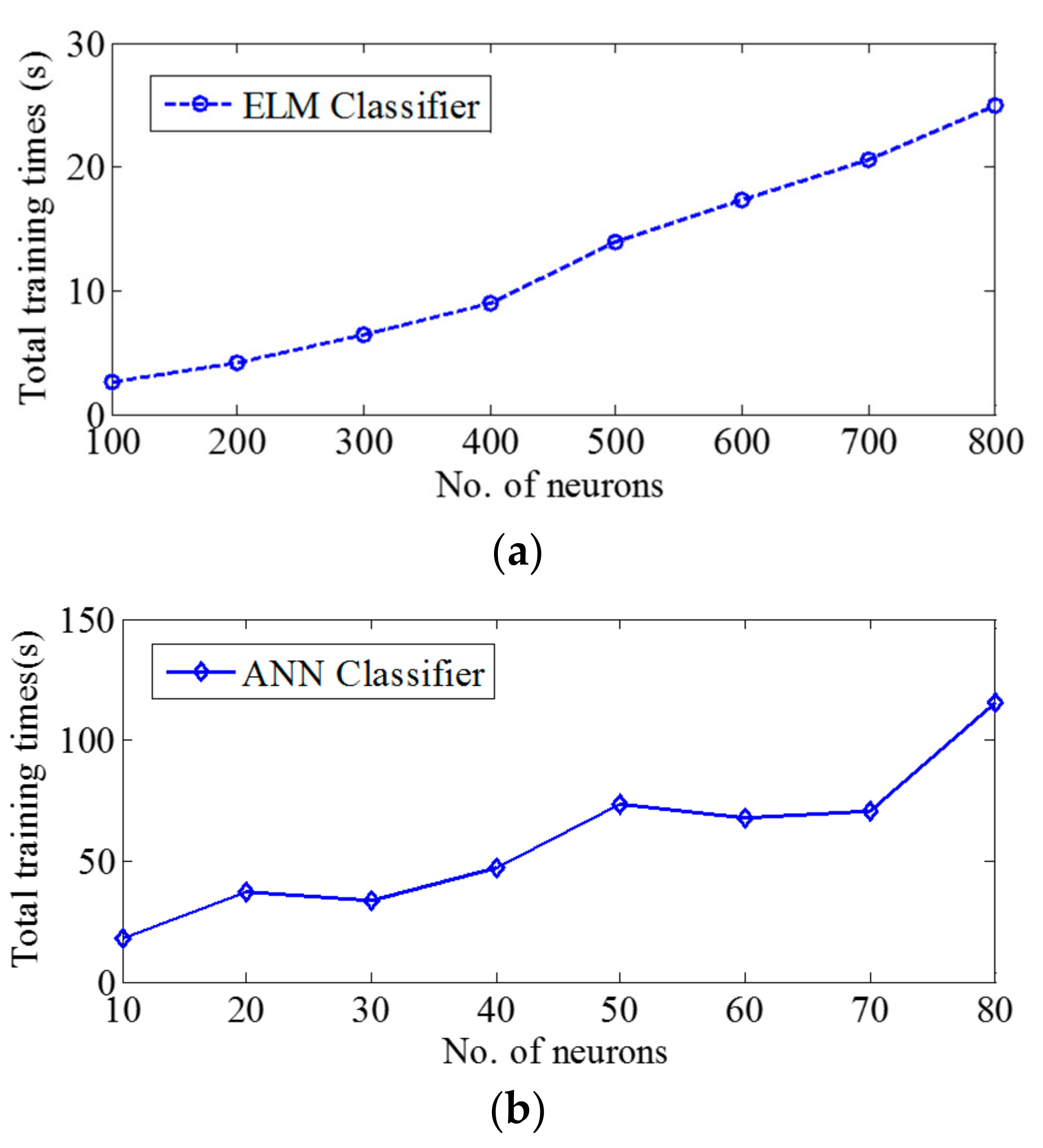1. Introduction
Sit to stand (SiSt) posture transition is a key component of mechanically demanding functional tasks in daily activities. The quality of life and functional independence highly depends on the ability to perform the SiSt posture transition. Many elderly people face difficulties in performing the SiSt transition successfully due to weakness in muscles. The failed transitions lead to a high occurrence of falls. In the US alone, each year, 2.5 million older people are admitted to emergency departments for fall injuries like head injury, broken bones and hip fracture [
1]. Therefore, for the last two decades, many researchers have analyzed the detection and characterization of postural transitions, including the SiSt transition, in a variety of different powered orthoses. In particular, to provide movement assistance in SiSt transitions to elderly people, a potential solution is a lower limb orthosis, which is an external device/brace that can be attached to the lower part of the body.
With the advances in actuation technologies and high-performance materials (e.g., carbon fiber), compact and lightweight orthoses are becoming more common. Commercial powered lower-limb orthoses, such as AlterG Bionic Leg [
2], are beginning to be used clinically for rehabilitation training. As such, it is reasonable to assume that powered lower-limb orthoses for older adults’ daily use would be available in the not-so-distant future. Recently, several orthoses have been developed for the treatment and rehabilitation of patients with lower-extremity problems [
3,
4,
5], gait event detection [
6,
7,
8] and assistance with locomotive activities of daily living [
9,
10,
11,
12,
13,
14,
15]. Methods such as electromyography (EMG) [
4,
9,
10,
11,
12,
13,
14,
15,
16,
17], measurement of wearable sensors [
6,
18,
19,
20], and pressure platforms [
21] have been used to recognize posture transitions.
Amongst all methods, surface EMG provides the most natural way to estimate the torque needed to perform a movement. An EMG interface to control a two-degrees-of-freedom orthosis to provide assistance for the shoulder joint while performing predefined movements was proposed in [
9]. The studies of [
4,
11] proposed joint models for wearable powered orthosis with artificial pneumatic muscles at the ankle and the knee. The pneumatic muscles were controlled using surface EMG. The pattern of activation of leg muscles during SiSt transitions was reported by [
16] to follow a predetermined order. A wearable robot Hybrid Assistive Limb was developed to provide physical support to patients in their daily tasks utilizing EMG signal [
13]. To detect the intention of the sit-to-stand and stand-to-sit movements (StSi), features from different numbers of EMG channels (e.g., 2, 8 or 16 channels) were used with a range of classifiers (e.g., LDA, neuro-fuzzy, radial basis neural network) in [
10,
12,
14,
15,
17].
Body-fixed sensors were introduced to movement analysis research in the early 1990s [
16] and offered an alternative to EMG for the identification of SiSt transitions. The study referenced in [
20] proposed a classifier (accuracy 96% in the healthy group and 92% in the chronic pain group) for SiSt and StSi detection in daily activity by placing a single inertial sensor on the trunk. A method using motion sensors to differentiate between the SiSt and the StSi transitions was presented in [
21]. The authors observed that high-fall-risk elderly fallers experienced a lower and more variable transition duration. The accelerometers were also used in [
22,
23] to estimate the SiSt transition duration. The method proposed in [
24] applied dynamic time warping to assess transitions during functional activities by gyroscope signals. The study of [
25] investigated entropy as a metric to detect SiSt transitions using motion sensors. A sensor system containing a seismic accelerometer and gyroscopes was proposed in [
26] to detect SiSt transitions. The study also investigated the transition duration and angular velocities to quantify SiSt transitions among young and older adults. An inertial sensor in [
27] was located at the waist to analyze SiSt and StSi transitions. Recently, the authors in [
28] proposed a method of detecting transitions (sensitivity 92% and specificity 88%) in Parkinson’s disease patients by placing a three dimensional accelerometer at the waist.
Getting ready for the standing-up motion is a process that is nontrivial for frail older adults. To reduce the load for the older users (both cognitive and physical), it is desirable to have an algorithm that automatically detects the user’s intention and initiates the motion assistance from the orthosis. While various methods have been proposed for the development and control of orthosis along with the detection of posture transition, significant challenges still exist for real-time implementation. In our previous work, we presented a multi-sensor based system to detect SiSt transitions without relying on complex EMG signals [
29]. The recognition model was proposed using a support vector machine trained on features extracted from sensors placed on the orthosis. However, the algorithm presented in [
29] resulted in a relatively low, but nevertheless significant amount of false positives. These false positives could force a seated person to receive unexpected motion which could lead to trauma or falls in the worst case scenario. Despite immense advances in the development of orthosis, less attention has been given to the issue of false positives in the SiSt detection. Therefore, the specific contributions of the current work are (1) the elimination of false positives for the reliable operation of the orthosis, (2) the early detection of the initiation of the SiSt transition and (3) the development of a computationally lightweight algorithm for early detection. A novel two-stage recognition algorithm is proposed to eliminate false positives and provide early detection of the transition. Neural networks classifiers (extreme learning machine and multilayer perceptron) were explored to develop a lightweight and computationally efficient SiSt detection algorithm.
3. Results
After the feature computation, the application of the mRMR algorithm followed by FFS led the feature dimensions to be reduced to an average of 86% of their original size.
Figure 4 illustrates the percentage of dimensionality reduction after the feature reduction process for different numbers of lagged epochs. The results of the assessment of the proposed method in terms of overall accuracy, detection time, false positives, and the number of the failure detection of SiSt transitions for both ELM and MLP classifiers are summarized in
Table 4 and
Table 5, respectively. Both ELM and MLP classifiers manifested the best performance in the case of the training feature vector for eight lagged epochs. The models presented 100% transition detection with no false positives at this lag. In transition level detection, both TP
t and TN
t were detected in 100% of the cases.
Figure 5 illustrates the detection of SiSt transitions for two trials, employing the ELM-trained model. Both in
Figure 5a,b, the model successfully detected the transitions without false positives.
Figure 6 illustrates boxplots for the detection times obtained from both the classifiers.
The average duration of a SiSt transition in the collected dataset was 1.30 ± 0.55 s. On average, the proposed methods detected the initiation of SiSt posture transitions at 0.19 ± 0.33 s (ELM) and 0.13 ± 0.32 s (MLP) after the beginning of the transition. In terms of the percentage of total time spent on transition, the method detected the transition at 14.3% and 10.0% into the transition respectively.
Comparison of execution times of both classifiers is shown in
Table 6. The MLP was faster at recognition than the ELM.
Figure 7 shows the total training time for varying number of neurons. The total training time for the ELM model was found to be five times faster than for the MLP model. The statistical analyses were done in each epoch’s analysis. Following the best-performing number of epochs analyses, there was no significant difference found in F1
e scores obtained from the ELM and the MLP classifiers (
p > 0.2027 and
p > 0.0910 for seven and eight lagged epochs respectively).
4. Discussion
The main goal of this study was to develop of an algorithm that could provide a user the ability to perform SiSt transitions in a reliable and safe manner without false positives. In addition, a lightweight and computationally efficient algorithm was desired.
Contrary to the complex and burdensome EMG-based detection methods, the presented approach used simple sensors attached to the orthosis frame, rather than to the body. Therefore, the proposed method has a potential for enabling non-EMG orthosis that could offer reliable and consistent performance. The study referenced in [
20] proposed a classifier for SiSt detection in daily activity and obtained 0.64 sensitivity and 0.82 specificity in the healthy group and 0.69 sensitivity and 0.74 specificity in the chronic pain group. Recently, the authors in [
28] proposed a SiSt detection method in Parkinson’s disease patients with 0.92 sensitivity and 0.88 specificity. The specificity reported in these studies indicates a significant number of false positives. In the present study, the SiSt transitions were detected from a wide variety of initial postures without false positives. SiSt detection using the eight lagged epochs achieved 0.99 Accuracy
e and a 0.72 F1
e score in the case of the ELM classifier, and 0.99 Accuracy
e and 0.78 F1
e score in the case of the MLP classifier.
A range of 89–94% reduction in the size of the feature vectors was achieved utilizing the mRMR algorithm with FFS, substantially reducing the computational burden.
Figure 4 illustrates the percentage of dimensionality reduction. The decrease in feature dimensionality could be potentially beneficial for real-time implementation of the algorithm on a microcontroller. Apart from the dimensionality reduction, it could be possible that not all of the sensors placed in the orthosis frame would contribute to the recognition of the SiSt transitions, which might allow the omission of some of the sensors in practical applications. Therefore, further investigation could be done to find out optimum location and selection of sensors.
One of the major contribution of the paper was the design of the two-stage recognition method. The proposed two-stage recognition method enabled the elimination of false positives in the detection of the SiSt transition. Note that every sit to stand transition state was associated with a sitting pattern. Therefore, during the recognition phase, the first stage classifier dealt with the detection of a sitting posture prior to the actual transition, which drastically reduced the possibility of incurring false positives. Given that the first stage classifier detected a sitting posture, the second stage classifier dealt with whether the SiSt transition had actually occurred or not. The system was able to eliminate possible false positives that occurred during activities associated with stand to sit transitions and walking. To the best of our knowledge, this paper is the first to critically study the false positives and propose an algorithm for the detection and elimination of false positives.
Our previous experiment [
29] showed that the support vector machine classifier could potentially be used to recognize SiSt transitions. However, it is computationally intensive and not well-suited for real-time implementation on battery powered embedded processors. The extreme learning machine model has gained popularity in Electroencephalography (EEG) classification, fall detection and activity recognition. This paper introduced ELM in SiSt transition detection. In addition to the ELM-based classification model, the MLP model was also explored and compared. Based on the experimental results in
Table 4 and
Table 5, both MLP and ELM worked equally well in terms of classification accuracy.
Table 6 demonstrates the execution time of both classifiers in the case of the eight lagged epochs. With regard to recognition time, the MLP model yielded faster recognition performance. The number of hidden neurons used in the algorithm directly impacted the computation complexity. For the best case eight lagged epochs, the number of neurons used in the MLP model (70) was much fewer than in the ELM model (600), therefore MLP outperformed ELM in recognition time. In terms of training time, the ELM model was found to be faster than the MLP model.
Figure 7 illustrates the cumulative overall training time for the number of neurons. The ELM model was found to be more linearly proportional to the number of neurons used compared to the MLP model. Given the fact that both classification models produced comparable results, and the ELM required less training time, the ELM classifier could be a good candidate especially in on-line adaptive systems that may retrain or update the classifier on-line.
The results in
Table 4 and
Table 5 also show that the number of lagged epochs had an impact on the number of false positives. Over all tested lagged epochs, the ELM classifier was found to be less prone to false positives as compared to the MLP classifier. Regarding the TPR
e, both the classifiers displayed lower accuracy at one lagged epoch and improved as the number of lagged epochs increased. It was observed that the TNR
e and Accuracy
e showed excellent performance in the cases of all lagged epochs. One potential reason of exhibiting such values could be the imbalanced dataset where the majority of the data belonged to non-transition labels. Therefore, the F1
e score was reported as a measure that did not take the true negatives into account. Note that the F1
e scores for different numbers of lagged epochs were greater than the TPR
e because false positives, one of the contributing factors in the computation of the F1
e scores, were virtually absent in the results. Also note that since the computed values were averaged across multiple trials, the mean values of TPR
e do not directly translate to the mean values of the F1
e scores.
The detection time was reported as a percentage of the transition period duration. Both the ELM and MLP classification algorithms were comparable in detection times. In
Figure 6, the detection times obtained from both classification models are represented as a box plot, with the mean shown as a plus sign, the median as a central thick line, and the 25th and 75th percentiles as a box. It was observed that the range of detection times varied with the number of lagged epochs.
For first few lagged epochs (up to 6), the detection times for both models exhibited a varying time range with a standard deviation of 0.08. However, as the number of lagged epochs increased, the models tended to exhibit less variation, with a standard deviation of 0.01.
As for the percentage of total transition time, the MLP demonstrated almost 5% earlier detection as compared to the ELM model.
A statistical two-tailed t-test (p > 0.05) for the F1e score (p > 0.2027 and p > 0.0910 for seven and eight lagged epochs respectively) indicated that the choice of the classifier did not affect the recognition performance.
In spite of the fact that the proposed method offers potential use in the assistance of elderly people, a limitation of this study is that only young healthy individuals were included, elderly people being excluded due to the potential fall risk from a pilot orthosis device. Consequently, the implemented algorithms were not verified on elderly people who may perform movement at a slow pace. Therefore, further studies are needed to test the performance of the proposed system on a wider population, including frail elderly individuals. Another limitation of this study is that the SiSt transitions of the participants were detected under the specific protocol. More studies are needed to carry out research outside of the laboratory and in a free-living environment that encompasses real-life, everyday activities. Finally, the real-time implementation of the proposed neural network-based algorithm on low-power embedded processors is a potential extension of this work.
